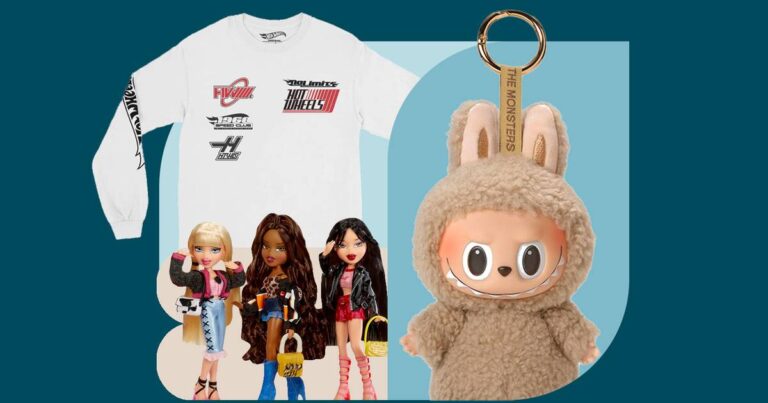When Labubu made it big in America this summer, it wasn’t just because it caught on with kids.
The fuzzy little demon toys, made by Chinese company Pop Mart, also became the hottest accessory for adults, prominently displayed on designer handbags, showed off on TikTok, and spotted on many a favorite celeb. That cultural pizzazz has helped more than double the company’s revenue, according to the Wall Street Journal.
Pop Mart isn’t the first to tap into the American “kidult” audience, and it’s not likely to be the last. Brands like Barbie and Hot Wheels from toy giant Mattel have long catered to an adult audience of toy appreciators and nostalgia-seekers, and other brands are jumping in: In 2023, doll company Bratz introduced an animated series that particularly pleased grown-up fans, while Trixie Mattel’s Trixie Cosmetics debuted a campaign and makeup collection with the Teletubbies in May.
The customer that possesses both childlike wonder and grown-up spending power is a key target for many brands, and it’s a market that’s poised to keep going, Juli Lennett, VP and toys industry advisor at research firm Circana, told us.
“Ever since the pandemic, the adult market for toys has been the growth area for the toy industry,” Lennett said. “When there are times of stress, which it feels like we’re getting into that even now, consumers do tend to lean into when they were children and lean into toys.”
Growth spurt
In the first quarter of 2025, toy sales for adults aged 18 or older increased 12% compared to the same time period in 2024, making them the fastest-growing age demographic for the toy industry, according to Circana. But kidults aren’t strictly aged 18+, according to Lennett. Rather, she said, Circana defines the kidult market as anyone 12 and up “who buys toys for themselves or receives toys.” This definition allows it to also examine the behavior of the 12–17 age demographic, which tends to engage with toys differently than both younger children and the 18-and-older crowd.
In the case of Labubu, the appeal seems to be cross-generational, albeit for different reasons. While younger kids might attach their little furry guys to school backpacks and rely on their parents to keep track of product drops, older customers are clipping their creepy keyrings to designer bags and keeping tabs on Pop Mart’s website themselves.
That adult engagement has allowed a wider swath of brands to get in on the hype: In June, Highsnobbery hosted a Labubu fashion show in New York’s Washington Square Park with prizes including a Coach bag, while Uniqlo announced a line of officially licensed Labubu T-shirts and sweatshirts that will roll out in August. Countless other brands made cheeky social media posts featuring the dolls as they took over the zeitgeist.
Marketing Brew informs marketing pros of the latest on brand strategy, social media, and ad tech via our weekday newsletter, virtual events, marketing conferences, and digital guides.
Despite their popularity with kids, Pop Mart is not particularly focused on catering to children. “The target audience for our product is the adult collector,” Emily Brough, Pop Mart’s head of licensing, said in an interview with the Wall Street Journal. “We are specifically hitting that Gen Z kidult customer, so they’re more collectible items than anything else, and so they’re definitely not marketed for children.”
Labubu isn’t the only toy taking off in the grown-up world. Roberto Stanichi, EVP of Hot Wheels, said that adults have long been a cornerstone of the toy-car brand’s audience due to its commitment to reflecting authentic car culture, but that in recent years, interest from adults has “accelerated dramatically.” The Hot Wheels Collector die-cast collection, which is built specifically for adults, has had sales triple since 2017, according to the company.
“I think it has to do a little bit with the moment that we live in, but at the same time, [there’s] this cross-generational nature of Hot Wheels,” Stanichi said. “1968 is when Hot Wheels came out. There are some of the original kids that played with Hot Wheels, not only have they shared that with their kids, but now some of them are starting to have grandkids. So you have three generations, full-cycle generations, of kids that grew up with Hot Wheels.”
Whether it’s a doll or a car, adults engaging with toy culture are often looking for a sense of belonging, Lennett said, and greater toy appreciation is creating community for older audiences.
“It kind of makes you feel good, and you’re part of a bigger group,” she said. “It’s social media–driven. You feel okay doing it, and you’re going to promote it,” she said.
Not now, honey; the kidults are talking
For brands that are embracing their adult audience, adult-focused messaging can look a little different than the marketing aimed at getting kids excited.
“When you’re talking [to] kids, there’s an element of the fantastical,” Stanichi said. When it comes to adults, “understanding what is moving in terms of cultural trends in car culture and how we can authentically tap into that and play into that is what’s really important.”
At Hot Wheels, adult-focused marketing is centered around immersive messaging and experiential, as well as brand partnerships, including collaborations with brands like Formula 1, Ferrari, and car brands in the Japanese domestic market.
By connecting with consumers beyond childhood, Stanichi said that the kidult market has allowed customer bases and toy brands to continue growing—together.
“It doesn’t matter how old you are,” he said. “You might change the way you interact with the brand, but it never ceases to be a part of your life.”


